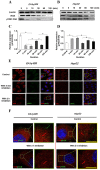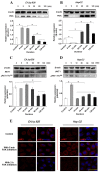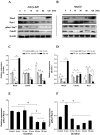Inhibition of cell migration by focal adhesion kinase: Time-dependent difference in integrin-induced signaling between endothelial and hepatoblastoma cells
- PMID: 29484384
- PMCID: PMC5846670
- DOI: 10.3892/ijmm.2018.3512
Inhibition of cell migration by focal adhesion kinase: Time-dependent difference in integrin-induced signaling between endothelial and hepatoblastoma cells
Abstract
angiogenesis plays an important role in the development and progression of tumors, and it involves a series of signaling pathways contributing to the migration of endothelial cells for vascularization and to the invasion of cancer cells for secondary tumor formation. Among these pathways, the focal adhesion kinase (FAK) signaling cascade has been implicated in a variety of human cancers in connection with cell adhesion and migration events leading to tumor angiogenesis, metastasis and invasion. Therefore, the inhibition of FAK in endothelial and/or cancer cells is a potential target for anti‑angiogenic therapy. In the present study, a small‑molecule FAK inhibitor, 1,2,4,5-benzenetetramine tetrahydrochloride (Y15), was used to study the effects of FAK inhibition on the adhesion and migration behaviors of vascular endothelial cells (VECs) and human hepatoblastoma cells. Furthermore, the time-dependent differences in proteins associated with the integrin-mediated FAK/Rho GTPases signaling pathway within 2 h were examined. The results indicated that the inhibition of FAK significantly decreased the migration ability of VECs and human hepatoblastoma cells in a dose-dependent manner. Inhibition of FAK promoted cell detachment by decreasing the expression of focal adhesion components, and blocked cell motility by reducing the level of Rho GTPases. However, the expression of crucial proteins involved in integrin-induced signaling in two cell lines exhibited a time-dependent difference with increased duration of FAK inhibitor treatment, suggesting different mechanisms of FAK-mediated cell migration behavior. These results suggest that the mechanism underlying FAK-mediated adhesion and migration behavior differs among various cells, which is expected to provide evidence for future FAK therapy targeted against tumor angiogenesis.
Conflict of interest statement
The authors declare that they have no competing interests.
Figures









Similar articles
-
CXCL1 from tumor-associated lymphatic endothelial cells drives gastric cancer cell into lymphatic system via activating integrin β1/FAK/AKT signaling.Cancer Lett. 2017 Jan 28;385:28-38. doi: 10.1016/j.canlet.2016.10.043. Epub 2016 Nov 8. Cancer Lett. 2017. PMID: 27832972
-
[Study on FAK regulation of migration of vascular endothelial cells depending upon focal adhesion proteins].Sheng Wu Yi Xue Gong Cheng Xue Za Zhi. 2013 Jun;30(3):567-71. Sheng Wu Yi Xue Gong Cheng Xue Za Zhi. 2013. PMID: 23865320 Chinese.
-
5'-Nitro-indirubinoxime, an indirubin derivative, suppresses metastatic ability of human head and neck cancer cells through the inhibition of Integrin β1/FAK/Akt signaling.Cancer Lett. 2011 Jul 28;306(2):197-204. doi: 10.1016/j.canlet.2011.03.006. Epub 2011 Apr 3. Cancer Lett. 2011. PMID: 21463917
-
Effect of surface chemistry on the integrin induced pathway in regulating vascular endothelial cells migration.Colloids Surf B Biointerfaces. 2015 Feb 1;126:188-97. doi: 10.1016/j.colsurfb.2014.12.019. Epub 2014 Dec 30. Colloids Surf B Biointerfaces. 2015. PMID: 25575348 Review.
-
Focal adhesion kinase and its signaling pathways in cell migration and angiogenesis.Adv Drug Deliv Rev. 2011 Jul 18;63(8):610-5. doi: 10.1016/j.addr.2010.11.001. Epub 2010 Nov 29. Adv Drug Deliv Rev. 2011. PMID: 21118706 Free PMC article. Review.
Cited by
-
Insulin-like Growth Factor-1 Influences Prostate Cancer Cell Growth and Invasion through an Integrin α3, α5, αV, and β1 Dependent Mechanism.Cancers (Basel). 2022 Jan 12;14(2):363. doi: 10.3390/cancers14020363. Cancers (Basel). 2022. PMID: 35053528 Free PMC article.
-
Psoralidin inhibits osteosarcoma growth and metastasis by downregulating ITGB1 expression via the FAK and PI3K/Akt signaling pathways.Chin Med. 2023 Mar 31;18(1):34. doi: 10.1186/s13020-023-00740-w. Chin Med. 2023. PMID: 37004120 Free PMC article.
-
The Impact of Spaceflight and Microgravity on the Human Islet-1+ Cardiovascular Progenitor Cell Transcriptome.Int J Mol Sci. 2021 Mar 30;22(7):3577. doi: 10.3390/ijms22073577. Int J Mol Sci. 2021. PMID: 33808224 Free PMC article.
-
Effects of Atypical Protein Kinase C Inhibitor (DNDA) on Lung Cancer Proliferation and Migration by PKC-ι/FAK Ubiquitination Through the Cbl-b Pathway.Onco Targets Ther. 2020 Feb 24;13:1661-1676. doi: 10.2147/OTT.S224866. eCollection 2020. Onco Targets Ther. 2020. PMID: 32158232 Free PMC article.
-
The Integrin Pathway Partially Mediates Stretch-Induced Deficits in Primary Rat Microglia.Mol Neurobiol. 2023 Jun;60(6):3396-3412. doi: 10.1007/s12035-023-03291-1. Epub 2023 Mar 1. Mol Neurobiol. 2023. PMID: 36856961
References
MeSH terms
Substances
LinkOut - more resources
Full Text Sources
Other Literature Sources
Medical
Molecular Biology Databases
Miscellaneous

